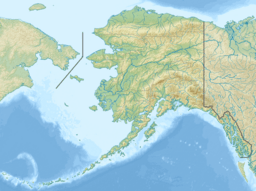Nugget Towers facts for kids
Quick facts for kids Nugget Towers |
|
|---|---|

Nugget Towers, northwest aspect
|
|
| Highest point | |
| Elevation | 5,378 ft (1,639 m) |
| Prominence | 778 ft (237 m) |
| Isolation | 1.73 mi (2.78 km) |
| Parent peak | Mount Wrather |
| Geography | |
| Location | Tongass National Forest Juneau Borough Alaska, United States |
| Parent range | Coast Mountains Boundary Ranges Juneau Icefield |
| Topo map | USGS Juneau B-2 |
| Climbing | |
| Easiest route | class 5.4 |
Nugget Towers is a cool mountain in southeast Alaska. It's actually a ridge with a few peaks, and the tallest one is about 5,378 feet (1,639 meters) high. This mountain is found near the edge of the Juneau Icefield in the Boundary Ranges.
You can find Nugget Towers east of the famous Mendenhall Glacier. It's about 10 miles (16 km) north of Juneau, a city in Alaska. The land around it is part of the Tongass National Forest, which is a huge protected area. Even though it's not the tallest mountain, it rises very steeply, about 3,500 feet (1,067 meters) from the valley below in a short distance. Water from the mountain flows into Nugget Creek and then into Mendenhall Lake, creating Nugget Falls. The name "Nugget Towers" was first used by the U.S. Geological Survey in 1965.
Climate Around Nugget Towers
The area where Nugget Towers is located has a subarctic climate. This means it has very cold, snowy winters and mild summers. Imagine lots of snow and chilly temperatures!
Weather systems from the Gulf of Alaska bring a lot of moisture. When these systems hit the Coast Mountains, the air is forced to rise. This process, called orographic lift, makes the air cool down and drop a lot of rain and snow.
Temperatures can get super cold, sometimes dropping below -20 °C. With the wind, it can feel even colder, like -30 °C! This cold climate helps keep the Mendenhall Glacier to the west and the huge Juneau Icefield to the north frozen. If you want to visit or climb Nugget Towers, July usually has the best weather.


